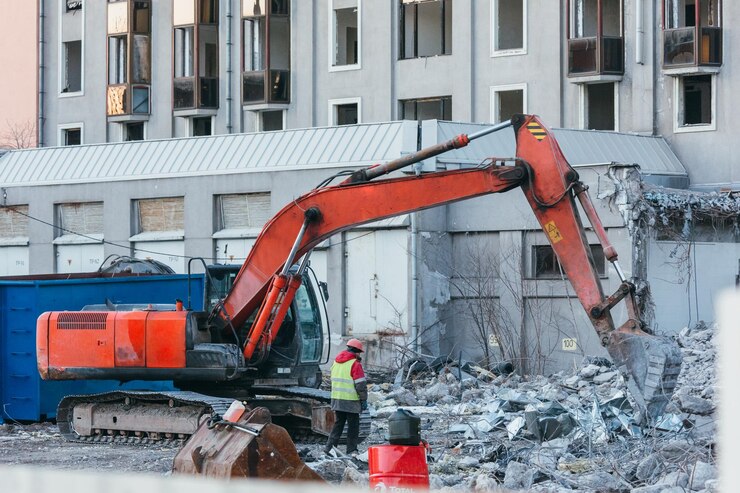Table of Contents
What Is Exterior Demolition?
Exterior demolition is the process of dismantling the outer parts of a structure. This can include tearing down walls, roofs, decks, and more. The reasons for undertaking an exterior demolition project can vary widely. Sometimes it’s about clearing the way for new construction, other times it’s part of a renovation where certain elements need to be replaced.
Types of Exterior Demolition
Understanding the type of demolition you need is crucial. Here are the primary categories:
- Partial Demolition: This involves removing only selected sections of a building. If you’re renovating, for instance, you might only need to take down an outdated wall or roof.
- Total Demolition: When a building is too damaged to salvage, total demolition is necessary. This method clears everything away, allowing for new construction to begin on a clean slate.
- Selective Demolition: This technique focuses on removing specific parts of a structure while preserving others. It’s often used in renovations to upgrade certain areas without affecting the entire building.
- Soft Demolition: This involves removing non-structural components like fixtures and fittings. It’s a way to minimize waste and maximize material reuse.
See Also DIY vs. Hiring a Pro: Which is Best for Your Demolition?
Why Do Exterior Demolitions?
There are several reasons why exterior demolition might be on your agenda:
- Structural Integrity: Buildings that are structurally unsound may pose safety risks, making demolition necessary.
- Renovation Needs: Upgrading or modernizing a building often requires removing old exterior features.
- New Developments: When a site is set for new construction, clearing the old structure is the first step.
- Compliance Issues: Sometimes, buildings fail to meet current safety or zoning regulations, necessitating their demolition.
Techniques for Successful Exterior Demolition
1. Planning and Preparation
Preparation is key to any successful demolition project. Here’s how to get started:
- Site Assessment: Evaluate the structure and surroundings to identify hazards and determine what permits are necessary.
- Obtain Permits: Always check with local authorities to understand which permits you’ll need to proceed legally.
- Asbestos Check: For older buildings, it’s wise to conduct an asbestos survey to ensure safe handling.
- Safety Planning: Create a detailed safety plan that outlines the precautions and gear required for the job.
2. Prioritizing Safety
Safety should always be your top priority. Here are some measures to keep in mind:
- Personal Protective Equipment (PPE): Equip everyone involved with hard hats, gloves, goggles, and respiratory protection.
- Secure the Site: Establish a clear perimeter to prevent unauthorized access.
- Emergency Protocols: Make sure everyone knows what to do in case of an emergency.
3. Essential Tools and Equipment
The tools you choose depend on the scale of your project. Here are some common ones:
- Excavators: Perfect for large-scale demolitions, these machines can handle heavy structures.
- Bobcats/Skid Steer Loaders: These compact machines are great for maneuvering in tight spaces during selective demolitions.
- Sledgehammers and Demolition Hammers: Handy for breaking down walls and removing stubborn fixtures.
- Reciprocating Saws: Ideal for cutting through various materials, making them a must-have for any demolition crew.
- Cranes: Necessary for safely lifting and removing heavy components.
- Dump Trucks: Essential for hauling away debris and waste.
See Also Transform Your Space: The Ultimate Guide to Garage Demolition Services
4. The Demolition Process
Here’s a typical process you can expect:
- Preparation: Start by ensuring all utilities are disconnected and the site is clear of hazards.
- Interior Demolition: If applicable, tackle the interior first, removing non-structural elements.
- Exterior Removal: Work from the top down—beginning with roofs and working down to walls and the foundation.
- Debris Management: Have a strategy in place for debris removal and recycling materials when possible.
5. Debris Disposal and Recycling
Proper disposal of debris is essential for minimizing your environmental footprint. Here are some options:
- Landfills: For materials that can’t be recycled, find a local landfill that follows regulations.
- Recycling Centers: Many materials like concrete, metal, and wood can be recycled; research local centers.
- Donation: If you have fixtures or materials in good condition, consider donating them to charities.
See Also Ultimate Guide to Drywall Removal: Tips and Techniques for a Successful Project
Tips for a Successful Exterior Demolition
Here are some best practices to keep in mind:
- Communicate regularly with your team to ensure everyone is on the same page.
- Document the entire process for future reference and potential legal needs.
- Stay flexible; sometimes unexpected challenges arise, and adaptability is crucial.
- Consider hiring professionals if the job feels overwhelming. Experienced demolition contractors can save time and ensure safety.
Conclusion
Exterior demolition is a complex process that requires careful planning and execution. Whether you’re renovating or starting anew, understanding the types and techniques involved can help ensure your project’s success. Always prioritize safety and sustainability, and consider consulting with professionals for larger projects to navigate the challenges effectively.
If you’re looking for professional assistance, look no further than DemoPrep’s Exterior Demolition Services. Our experienced team is equipped with the right tools and techniques to handle your demolition needs efficiently and safely. Contact us today to discuss how we can help you with your next project!

